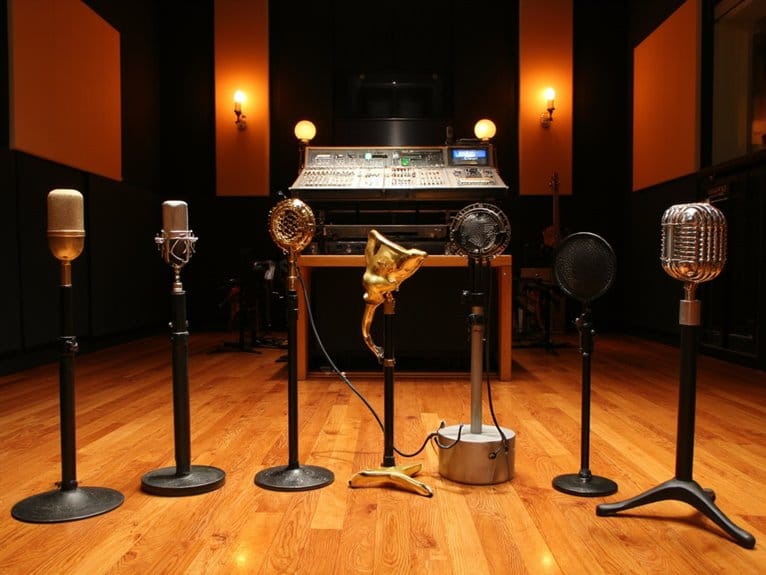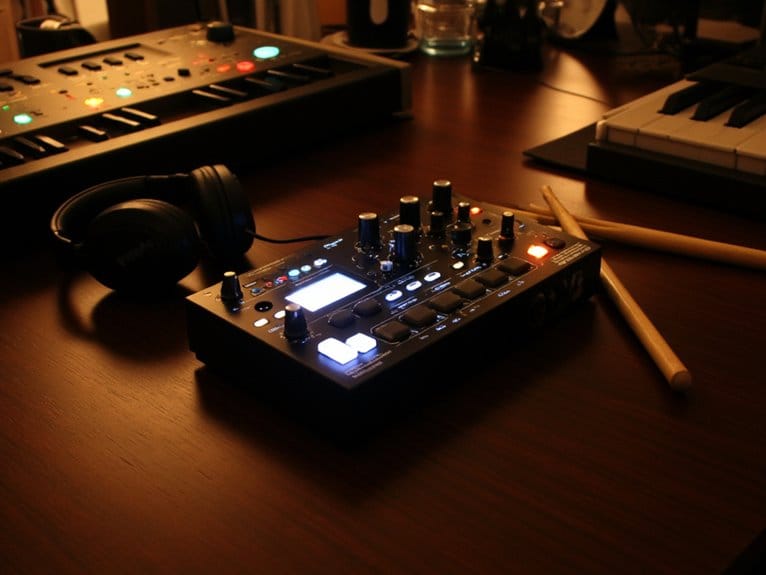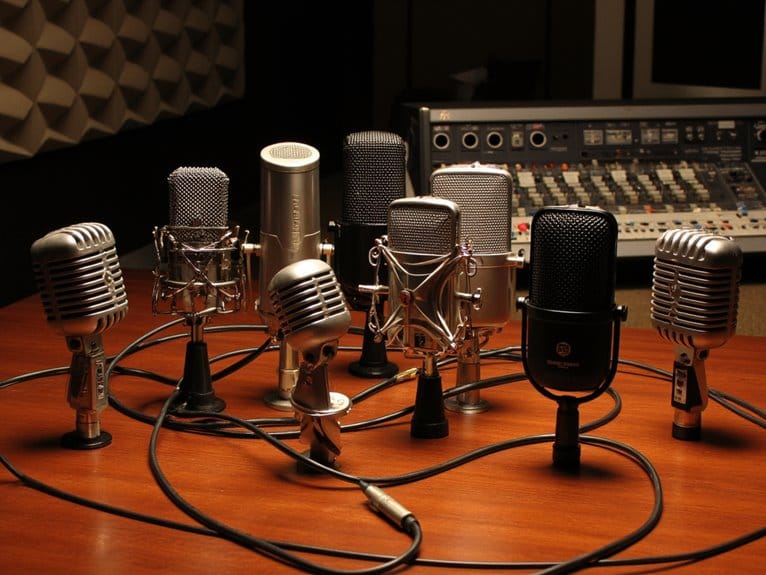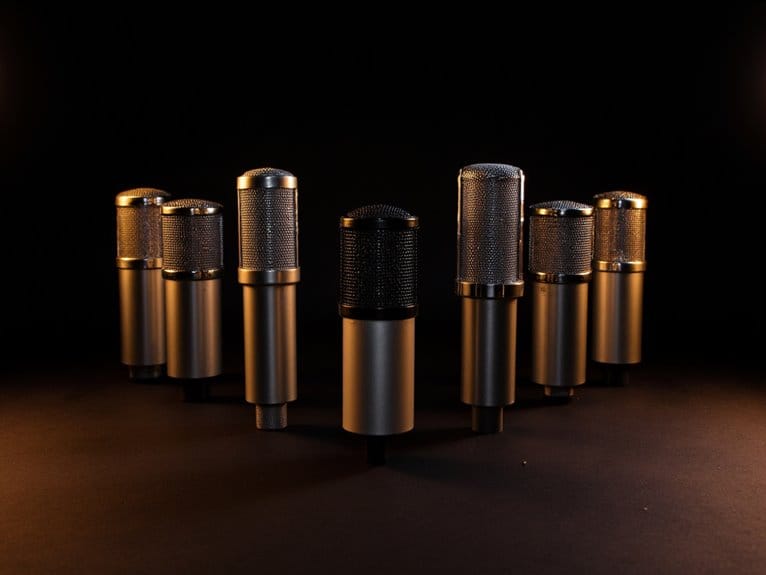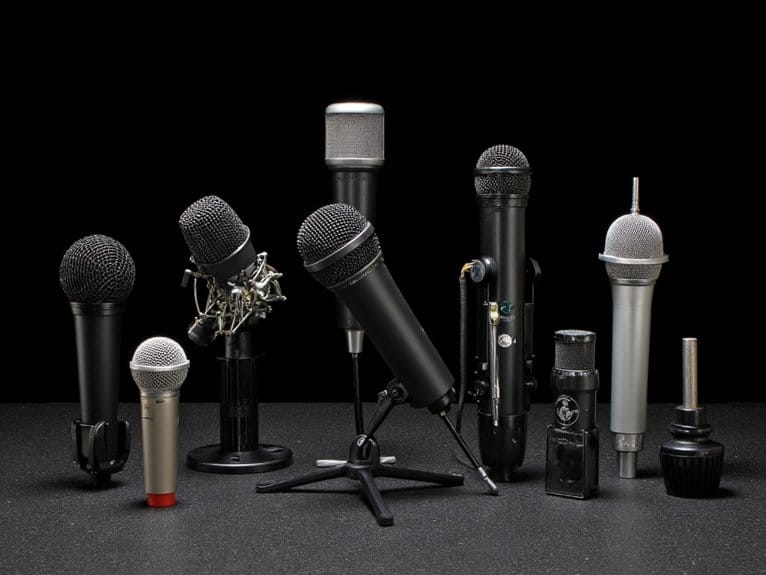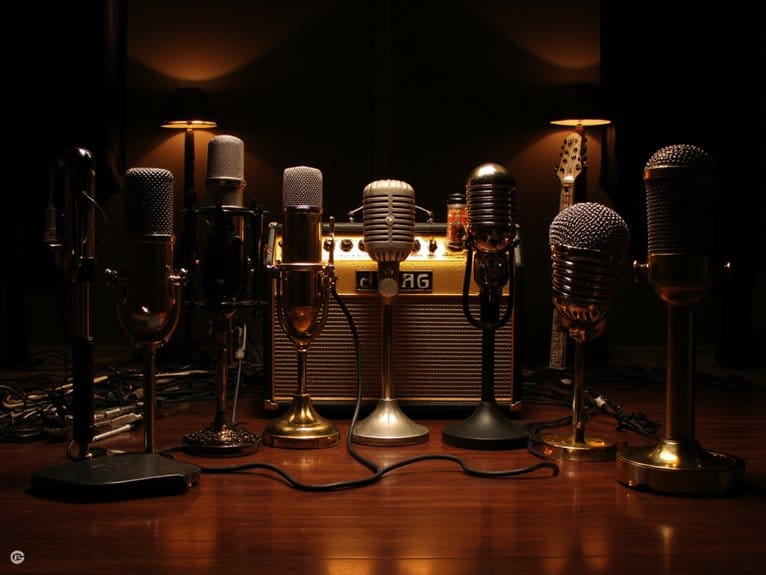10 Best Studio Microphones for Professional Recording
After testing dozens of studio microphones this year, I’ve identified ten models that consistently deliver professional results: the FIFINE T669 offers excellent entry-level performance with its cardioid condenser capsule and complete kit for $70, while the Stellar X2 provides premium studio quality with its large diaphragm design and sub-13dBA noise floor at $199. The Blue Yeti’s versatile four-pattern array suits content creators, and the RØDE NT1’s exceptional 4dB noise floor makes it ideal for vocals. Each microphone below offers specific advantages that’ll transform your recordings.
We are supported by our audience. When you purchase through links on our site, we may earn an affiliate commission, at no extra cost for you. Learn more.
Notable Insights
- Stellar X2 and Stellar X2 Vintage offer professional studio quality with large diaphragm condensers and ultra-low noise floors below 13dBA.
- RØDE NT1 features a true 1-inch condenser capsule with exceptional 4dB noise floor and complete studio package including shockmount.
- Condenser microphones excel for studio vocals and instruments due to superior sensitivity, though they require 48V phantom power.
- Professional microphones should offer 20Hz-20kHz frequency response, low self-noise, and high SPL handling for versatile recording applications.
- XLR connectivity with audio interfaces provides better signal quality than USB options for serious studio recording and production work.
Stellar X2 Large Diaphragm Cardioid Condenser XLR Microphone
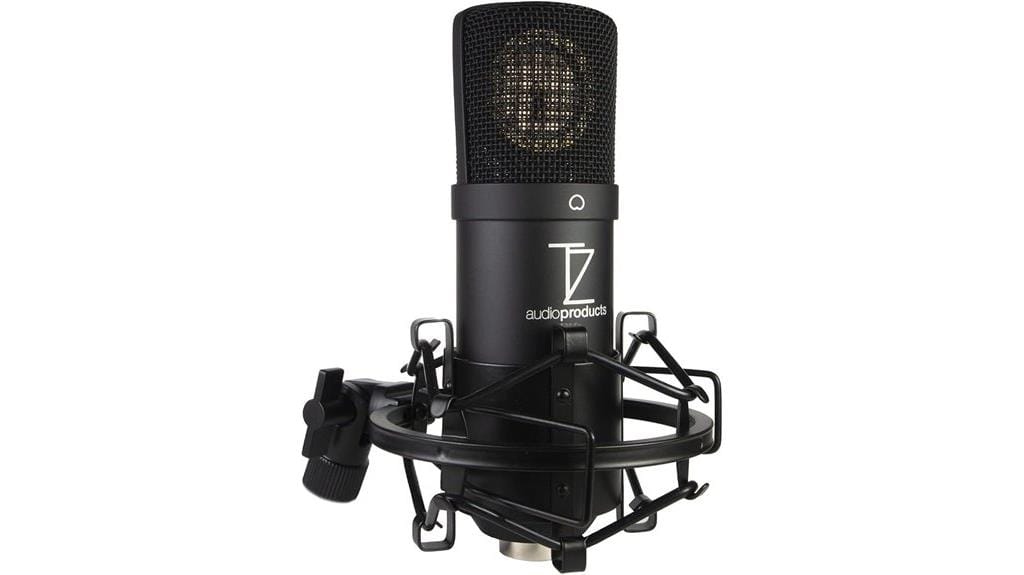
Professional content creators, musicians, and podcasters who demand studio-quality recordings will find their match in this large diaphragm condenser microphone, which combines exceptional technical specifications with practical durability. You’ll appreciate the Stellar X2’s transformerless JFET circuit design featuring high-tolerance German capacitors, which delivers remarkably low self-noise below 13dBA and maintains signal clarity across its full 20Hz-20kHz frequency range. The high-grade brass and Japanese mylar diaphragm construction guarantees increased sensitivity while the high-strength iron body withstands daily studio use, though you’ll need 48V phantom power and should consider room treatment given its exceptional ambient noise sensitivity.
Best For: Professional content creators, musicians, and podcasters who need studio-quality recordings and have treated acoustic spaces with 48V phantom power capabilities.
Pros:
- Exceptional technical performance with transformerless JFET circuit, low self-noise below 13dBA, and full 20Hz-20kHz frequency range
- Premium construction featuring high-grade brass and Japanese mylar diaphragm with high-strength iron body for durability
- Complete professional package including aluminum carrying case, spring mount, adapters, and wind protection accessories
Cons:
- Requires 48V phantom power and XLR audio interface, adding to setup complexity and cost
- High sensitivity to ambient noise makes it unsuitable for untreated rooms or noisy environments
- Higher price point at $199 with counterfeit products being sold at lower prices from unofficial sources
Stellar X2 Vintage Large-Diaphragm Cardioid Condenser XLR Microphone
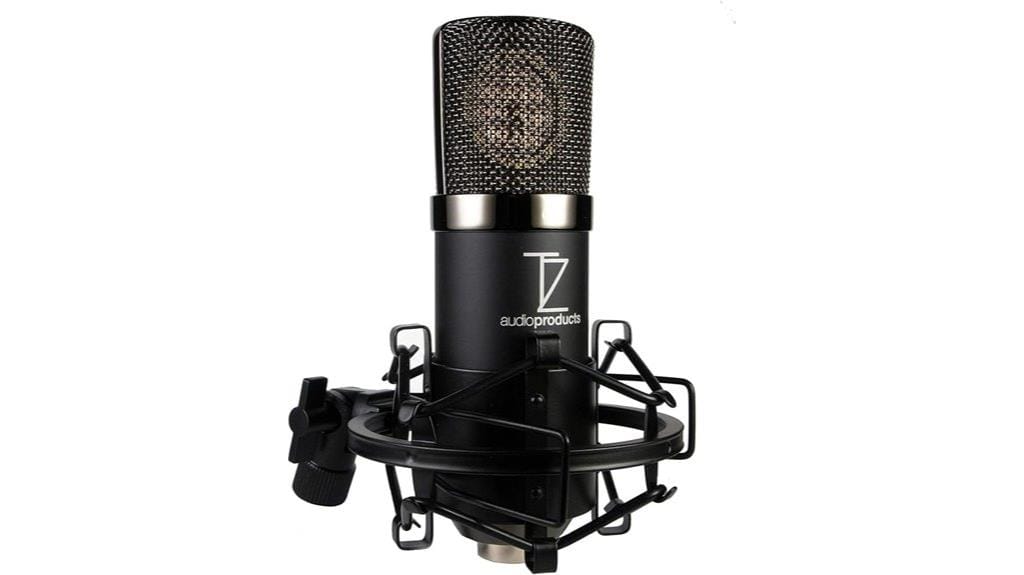
Musicians seeking that coveted vintage tube warmth without the hefty price tag will find the Stellar X2 Vintage Large-Diaphragm Cardioid Condenser XLR Microphone delivers remarkable value through its U47-style capsule design, which captures the essence of classic studio microphones that shaped decades of iconic recordings. The custom transformer-less FET circuit, featuring German components and achieving a noise floor below 10 dBA, guarantees professional-grade performance with exceptional signal clarity. You’ll appreciate the high-grade brass construction paired with imported Japanese mylar, delivering increased sensitivity for both vocal recordings and acoustic instruments, while the steel body’s electrostatic finish provides durability that withstands regular studio use.
Best For: Musicians, content creators, and home studio enthusiasts seeking professional vintage sound quality for vocal recordings and acoustic instruments without the high cost of classic tube microphones.
Pros:
- U47-style capsule with high-grade brass and Japanese mylar delivers authentic vintage warmth and increased sensitivity
- Professional-grade performance with German FET components achieving sub-10 dBA noise floor and 130 dB signal-to-noise ratio
- Complete package includes travel case, pop filter, and adapter screw for immediate studio use
Cons:
- Requires 48V phantom power which may limit compatibility with some basic audio interfaces
- Shock mount quality has been criticized by some users as inadequate for the microphone’s performance level
- Fixed cardioid pattern offers less versatility compared to multi-pattern microphones in the same price range
Logitech Blue Yeti USB Microphone for Gaming, Streaming & Podcast
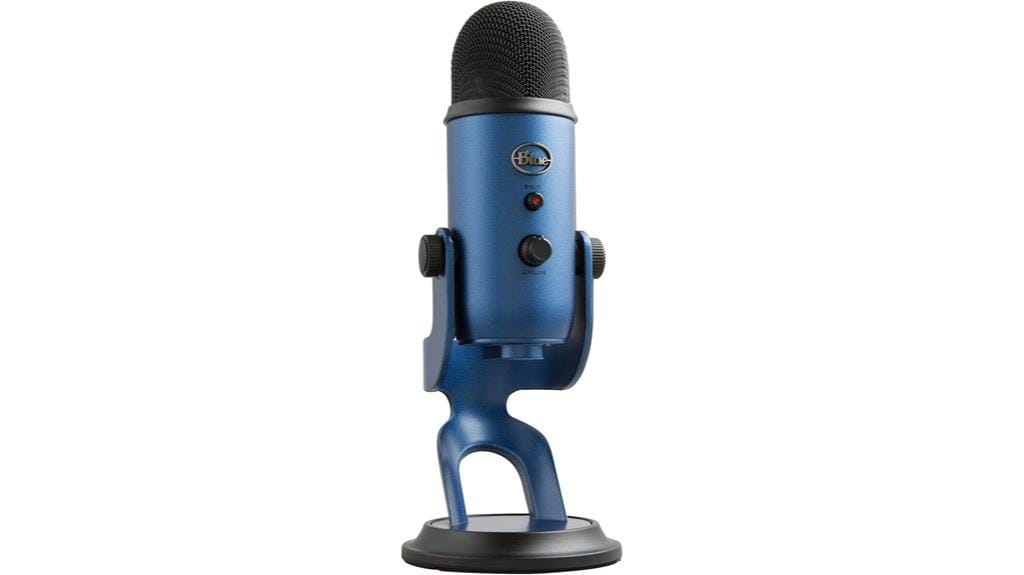
When you’re diving into content creation, streaming, or podcasting, the Logitech Blue Yeti USB Microphone stands out as one of the most versatile studio microphones you’ll encounter, offering a custom three-capsule array that delivers broadcast-quality sound without the complexity of traditional XLR setups. I’ve found its four pickup patterns—cardioid, omni, bidirectional, and stereo—particularly useful for adapting to different recording scenarios, while the onboard controls for headphone volume, pattern selection, and instant mute keep everything within arm’s reach. The Blue VOICE software genuinely enhances vocal clarity, though you’ll need to account for its 3.2-pound weight and that perpetually blinking mute indicator.
Best For: Content creators, streamers, and podcasters who need professional broadcast-quality audio with versatile recording patterns and plug-and-play USB convenience.
Pros:
- Four pickup patterns (cardioid, omni, bidirectional, stereo) provide exceptional flexibility for various recording scenarios
- Onboard audio controls for headphone volume, pattern selection, instant mute, and mic gain keep everything accessible
- Blue VOICE software enhances vocal clarity with advanced modulation and HD audio samples
Cons:
- Heavy 3.2-pound weight makes it less portable than lighter alternatives
- Perpetually blinking mute indicator can be distracting during recording sessions
- Sensitive Mini USB port requires careful handling to avoid connection issues
RØDE NT1 Signature Series Condenser Microphone with SM6 Shockmount and Pop Filter
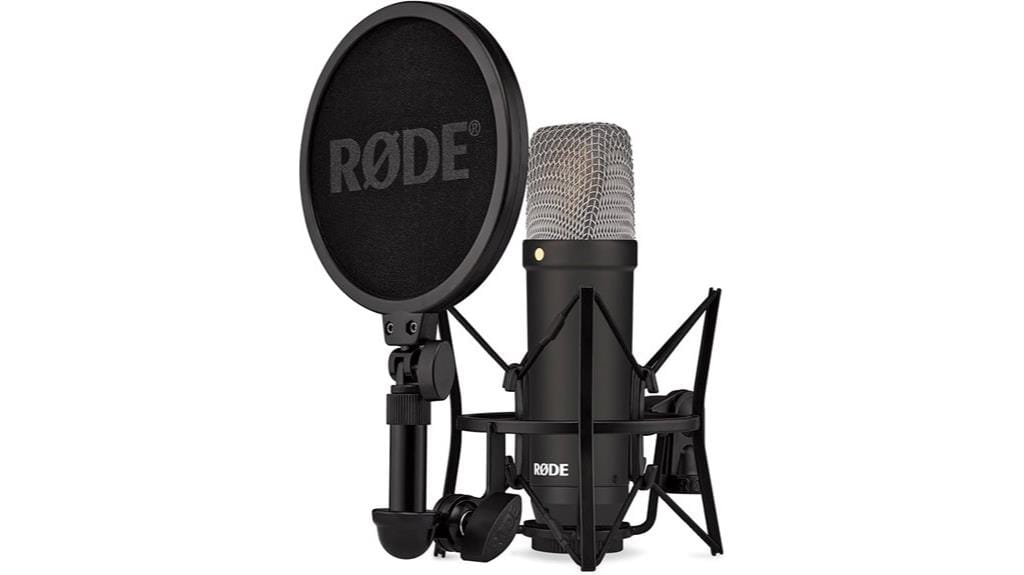
The RØDE NT1 Signature Series stands out as an exceptional choice for content creators and home studio enthusiasts who demand professional-grade audio without the intimidating complexity that often accompanies high-end recording equipment. You’ll appreciate its HF6 1-inch true condenser capsule, which delivers remarkably smooth frequency response with rich bass, detailed midrange, and sparkling highs that’ll make your vocals shine. The included SM6 shockmount and pop filter eliminate unwanted vibrations and plosives, while the extremely low 4 dB noise floor guarantees clean recordings even in less-than-ideal environments. With its impressive 78 dB signal-to-noise ratio and high SPL handling capabilities, you’re getting serious performance that consistently earns 4.7-star ratings from users worldwide.
Best For: Content creators, podcasters, musicians, and home studio enthusiasts who want professional-grade vocal and instrument recording quality with user-friendly setup and operation.
Pros:
- Exceptional audio quality with HF6 1-inch true condenser capsule delivering smooth frequency response and extremely low 4 dB noise floor
- Complete professional package includes studio-grade SM6 shockmount, pop filter, and premium XLR cable for immediate use
- Outstanding reliability and customer satisfaction with 4.7-star ratings, 10-year warranty, and Australian precision manufacturing
Cons:
- Requires phantom power and audio interface, adding to overall setup cost for beginners
- Some users report occasional popping noises during operation
- At 313 grams, it’s heavier than some competing condenser microphones which may stress lighter boom arms
FIFINE Studio Condenser USB Microphone Kit with Adjustable Boom Arm Stand (T669)
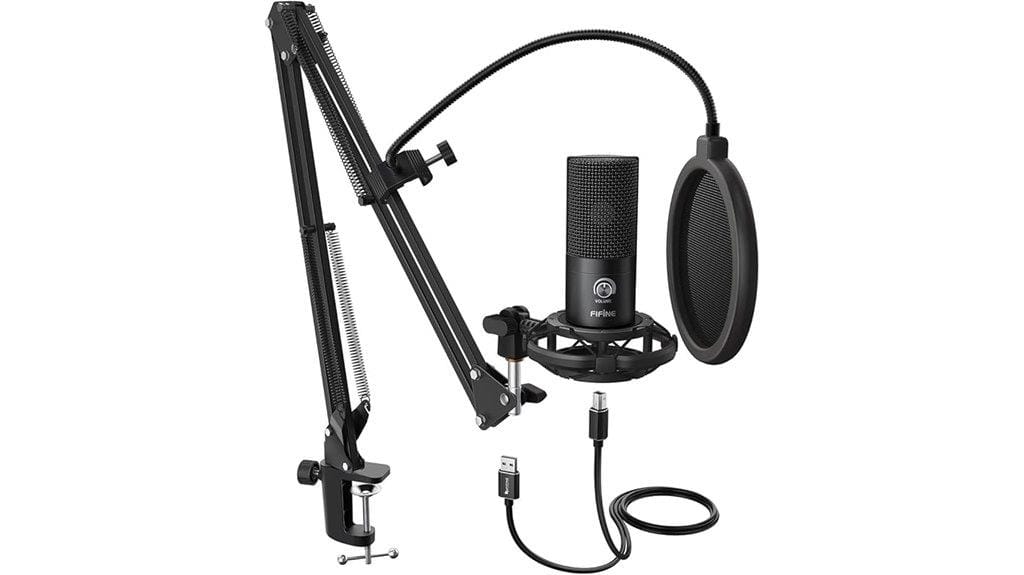
Budget-conscious content creators who need professional-quality audio without breaking the bank will find exceptional value in the FIFINE Studio Condenser USB Microphone Kit (T669), which delivers crystal-clear recording capabilities through its cardioid condenser capsule and extensive accessory package. You’ll appreciate the wide 20Hz-20KHz frequency response and impressive 78 dB signal-to-noise ratio, which guarantees your recordings capture every nuance while minimizing background interference. The complete kit includes an adjustable all-steel scissor arm with 180° vertical and 135° horizontal positioning, shock mount, and double pop filter, providing everything you need for immediate podcast or streaming setup without additional purchases.
Best For: Budget-conscious content creators, podcasters, streamers, and YouTubers who need professional-quality audio recording equipment with a complete accessory package for immediate setup without additional purchases.
Pros:
- Crystal-clear audio quality with cardioid condenser capsule, wide 20Hz-20KHz frequency response, and 78 dB signal-to-noise ratio for professional recording results
- Complete all-in-one kit includes adjustable all-steel scissor arm stand, shock mount, double pop filter, and 8.2 ft USB cable with no additional accessories needed
- Plug-and-play USB connectivity with no drivers required, compatible with PC, laptop, and popular recording software like OBS and Audacity
Cons:
- Not compatible with gaming consoles like Xbox or mobile phones, limiting versatility for some users
- Occasional background noise capture and boom arm stability issues reported by some users
- Pop filter adjustments can be challenging to position correctly for optimal performance
MAONO Condenser Cardioid Podcast Microphone with Studio Headphones (AU-A04H)
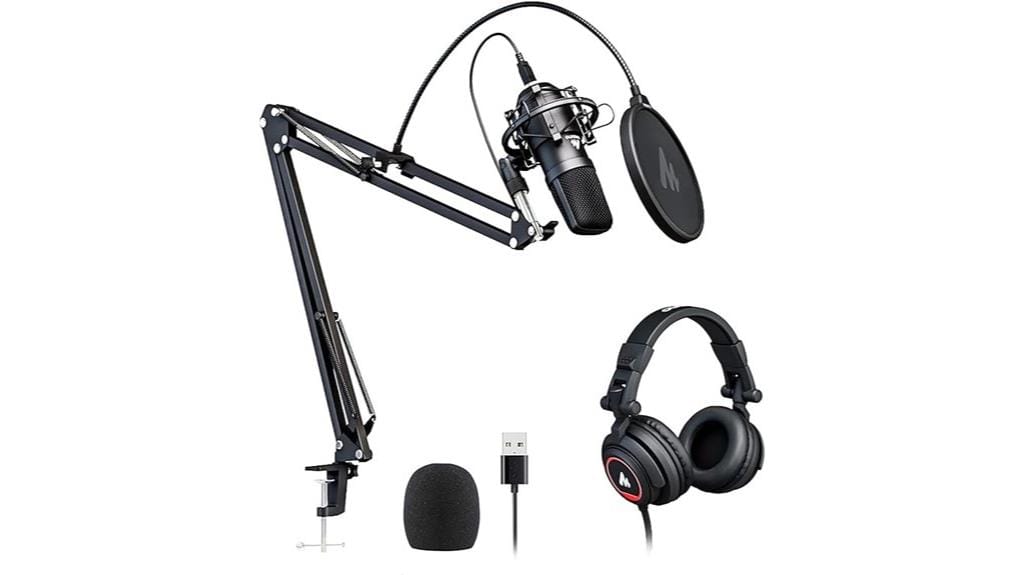
Content creators and podcasters seeking an all-in-one recording solution will find exceptional value in the MAONO AU-A04H, which combines a professional-grade condenser microphone with studio-quality headphones in a single, extensive package. You’ll appreciate the microphone’s 192kHz/24bit sampling rate and 16mm electret condenser transducer, which delivers smooth frequency response from 30Hz to 16kHz that’s particularly well-suited for vocal recording and voice-over work. The included studio headphones feature proprietary 50mm drivers with active noise reduction, while the thorough accessory kit provides everything you need including an adjustable scissor arm stand, shock mount, and pop filter for immediate professional setup.
Best For: Content creators, podcasters, and voice-over artists who want a complete recording solution with professional-grade microphone and studio headphones in one package.
Pros:
- Complete all-in-one package includes microphone, studio headphones, and comprehensive accessories like scissor arm stand, shock mount, and pop filter
- High-quality audio specifications with 192kHz/24bit sampling rate and smooth 30Hz-16kHz frequency response optimized for vocal recording
- Wide compatibility across multiple platforms (Mac, Windows, Linux) with both USB and 3.5mm connections, plus included adapters
Cons:
- Frequency response range of 30Hz-16kHz is more limited compared to some higher-end microphones that extend beyond 20kHz
- USB 2.0 connection may be considered outdated compared to newer USB 3.0 or USB-C standards
- As an all-in-one bundle, individual components may not match the quality of dedicated separate microphone and headphone purchases at similar price points
Upgraded Studio Recording Microphone with Isolation Shield & Pop Filter
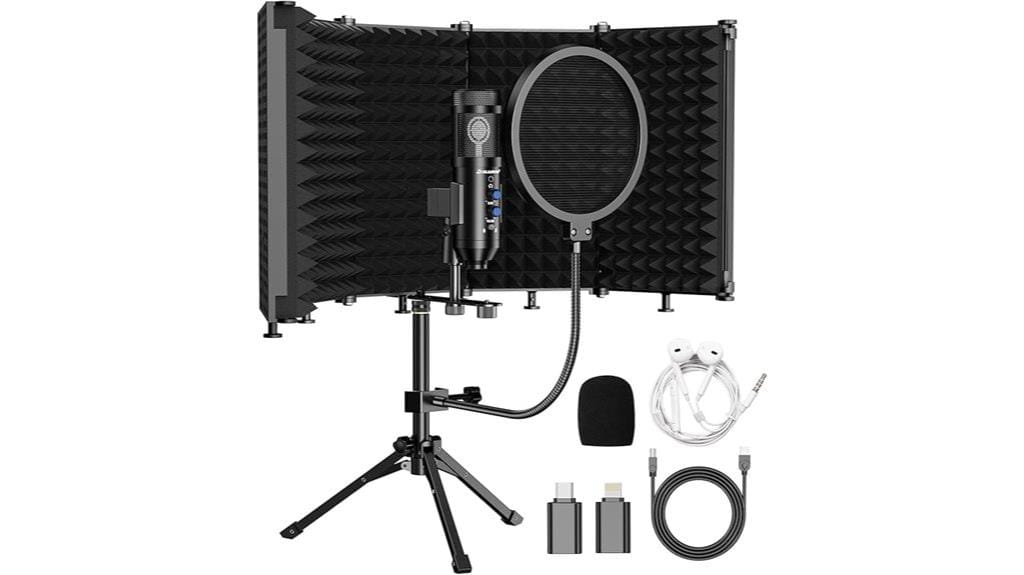
When you’re starting your podcasting journey or stepping into home recording, an all-in-one microphone kit can eliminate the guesswork of assembling compatible components piece by piece. This upgraded studio microphone delivers impressive 192kHz/24Bit sampling rates with a 16mm diaphragm that captures frequencies from 30Hz to 16kHz, ensuring your voice comes through with crystal clarity. The foldable isolation shield features five high-density acoustic panels that effectively reduce background noise, while the included pop filter prevents those annoying plosive sounds that can ruin otherwise perfect takes. You’ll appreciate the plug-and-play USB connectivity that works seamlessly with smartphones, laptops, and PCs without requiring additional hardware investments.
Best For: Beginner podcasters, home studio enthusiasts, and content creators who want a complete recording solution with professional-quality audio capture and effective noise reduction in a convenient all-in-one package.
Pros:
- Complete kit includes everything needed for professional recording: microphone, isolation shield, pop filter, tripod, adapters, headphones, and cables
- High-quality audio specifications with 192kHz/24Bit sampling rate and wide frequency response (30Hz-16kHz) for crystal-clear sound capture
- Plug-and-play USB connectivity works seamlessly with smartphones, laptops, and PCs without requiring additional hardware or drivers
Cons:
- Some users report occasional static issues that can interfere with recording quality
- Components can be difficult to adjust and position properly during setup
- At 4.1 pounds total weight, the kit may be less portable than expected for mobile recording situations
RØDE NT1 5th Generation Studio Condenser Microphone with XLR and USB Outputs
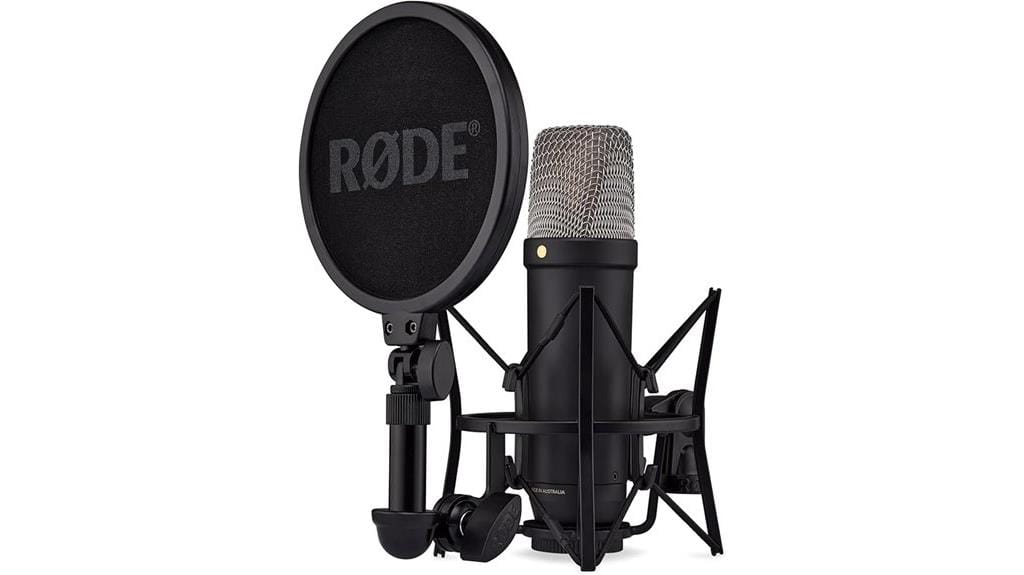
The RØDE NT1 5th Generation stands out as an exceptional choice for creators who demand professional-grade audio quality without sacrificing convenience, offering both XLR and USB connectivity in a single, meticulously crafted package. You’ll appreciate its remarkably low 4 dB self-noise level, which, frankly, puts many pricier competitors to shame, while the 32-bit float recording capability guarantees you’ll capture every nuance without worrying about clipping. The military-grade ceramic coating on its aluminum body means this microphone will likely outlast your current recording setup, and at 308 grams, it strikes that sweet spot between substantial build quality and manageable weight for extended sessions.
Best For: Content creators, musicians, and podcasters who need professional studio-quality recording with the flexibility of both XLR and USB connectivity for home studios and professional setups.
Pros:
- Exceptionally low 4 dB self-noise level and 32-bit float recording capability ensure pristine audio quality without clipping
- Dual XLR and USB connectivity provides versatility for different recording environments and setups
- Military-grade ceramic coating and high-grade aluminum construction offer exceptional durability and longevity
Cons:
- Pop filter design could be improved according to customer feedback
- Lacks a built-in hi-pass filter option that some users have requested
- Single-channel recording may limit multi-source recording applications
Factors to Consider When Choosing Mics for Studio
When I’m helping someone choose their first studio microphone, or even their tenth one, I’ve learned that five critical factors will determine whether you’ll love your purchase or regret it within the first recording session. The microphone type you select, whether dynamic or condenser, combined with the polar pattern that captures sound from specific directions, will fundamentally shape how your recordings sound in your particular space. I always tell people to examine the frequency response range, signal-to-noise ratio, and connectivity options before they buy, because these technical specifications directly impact whether the microphone will deliver professional results with your existing equipment and recording environment.
Microphone Type Selection
Selecting studio microphones requires careful consideration of several technical factors that’ll dramatically impact your recording quality, and honestly, I’ve learned this lesson through plenty of trial and error over the years. Dynamic microphones offer exceptional durability and rejection of background noise, making them perfect for tracking loud instruments like drums and guitar amplifiers, while condenser microphones provide superior sensitivity and extended frequency response that captures vocal nuances with remarkable clarity. I’ve found that condensers excel in controlled studio environments where their 20Hz-20kHz range truly shines, though they require phantom power from your audio interface. Dynamic mics, on the other hand, work reliably without external power and handle high sound pressure levels without distortion.
Polar Pattern Options
Understanding polar patterns has saved me from countless recording headaches, and I’ll tell you why this seemingly technical concept matters more than most beginners realize. Cardioid patterns remain my go-to choice for vocal isolation, effectively capturing sound from the front while rejecting unwanted background noise from the sides and rear. When I’m recording group sessions or capturing room ambience, omni-directional microphones prove invaluable, picking up sound equally from all directions with natural spatial characteristics. Bidirectional patterns excel during face-to-face interviews, where I need front and back sensitivity while eliminating side interference. I particularly appreciate microphones offering multiple polar patterns, as they provide flexibility for different recording scenarios without requiring separate microphone purchases, ultimately maximizing studio versatility.
Frequency Response Range
Although frequency response might sound intimidating at first, I’ve learned that this specification determines whether my recordings capture the full richness of sound or leave me wondering why something feels missing in the mix. Most studio microphones cover 20 Hz to 20 kHz, which matches human hearing range, but I’ve discovered that wider ranges don’t always mean better performance for specific applications. For vocal work, I prefer microphones with 30 Hz to 16 kHz response since they excel at capturing speech nuances without unnecessary low-end rumble. The frequency response curve tells the real story, showing me which frequencies get emphasized or attenuated, helping me select microphones that complement my recording goals rather than working against them.
Signal-to-Noise Ratio
While frequency response shapes the tonal character of my recordings, I’ve found that signal-to-noise ratio determines whether those carefully captured frequencies emerge from a bed of unwanted hiss or stand out with pristine clarity. I consider 70 dB the minimum benchmark for studio work, though I prefer microphones exceeding 80 dB for professional applications where audio fidelity can’t be compromised. Self-noise levels below 13 dBA greatly impact my vocal and instrumental captures, particularly in untreated spaces where environmental acoustics aren’t controlled. For voiceovers and music production, I’ve learned that high SNR microphones allow dynamic sound capture without interference, ensuring my recordings maintain professional standards that clients expect from studio-quality work.
Connectivity Requirements
When I’m selecting microphones for my studio setup, connectivity becomes the foundation that determines not only how easily I can integrate new equipment into my workflow, but also the ceiling for audio quality I can achieve. USB microphones offer plug-and-play simplicity that’s perfect for beginners, connecting directly to computers without additional gear, though they’re limited by device compatibility issues with gaming consoles and smartphones. XLR connections require audio interfaces with phantom power, adding complexity and cost, but they open the door to professional-grade preamps, mixers, and superior audio fidelity that I rely on for client work. Some mics feature dual USB/XLR outputs, giving me flexibility between digital convenience and analog quality depending on each project’s demands.
Budget Considerations
Three critical budget tiers define the studio microphone landscape, and I’ve learned that understanding where each price point delivers diminishing returns can save both money and frustration in building a capable recording setup. Entry-level microphones around AU$70 provide surprising quality for podcasting and basic vocal work, though I’ve found they lack the nuanced frequency response needed for professional music production. Mid-range options between AU$100-150 offer the sweet spot for most home studios, delivering reliable performance without breaking budgets. Professional models exceeding AU$200 become worthwhile when your projects demand broadcast-quality sound or you’re recording commercially. Don’t forget accessories like shock mounts, pop filters, and boom arms, which can add AU$50-100 but dramatically improve any microphone’s performance and versatility.
Room Acoustics Impact
Beyond the financial investment in quality microphones, I’ve discovered that your recording environment fundamentally determines whether that expensive condenser microphone performs like a professional tool or sounds like it’s trapped inside a bathroom. Hard surfaces create reflections and resonances that introduce unwanted background noise, effectively sabotaging even the most sophisticated microphone’s ability to capture clean audio. I’ve learned that acoustic treatment, including sound-absorbing panels and isolation shields, noticeably minimizes these interferences and enhances recording quality across various environments. The microphone’s polar pattern also matters importantly, as cardioid patterns reject side and rear sounds more effectively than omnidirectional designs. Proper placement relative to reflective surfaces reduces undesirable noise considerably, improving overall sound fidelity in any recording space.
Intended Recording Purpose
Although I’ve spent countless hours testing microphones across different scenarios, I’ve realized that your specific recording purpose should dictate your microphone choice more than any generic recommendation or flashy marketing claim. When I’m recording vocals, I consistently reach for condenser microphones because their sensitivity and wide frequency response capture those subtle breath nuances that make performances shine. However, if you’re tracking loud guitars or drums, dynamic mics handle high sound pressure levels without the distortion that’ll ruin your take. For podcast creators and streamers, USB microphones offer that plug-and-play simplicity I wish existed when I started, while XLR setups provide superior flexibility for serious studio work requiring audio interfaces.
Frequently Asked Questions
How Often Should I Replace My Studio Microphone for Optimal Recording Quality?
I don’t recommend replacing studio microphones on a schedule since quality mics last decades with proper care. I’ll replace mine only when it’s physically damaged or my recording needs considerably change.
What Room Acoustics Are Needed to Maximize Microphone Performance in Home Studios?
I’ll help you create ideal room acoustics for your home studio. You’ll need acoustic treatment panels, bass traps in corners, and proper mic positioning. Control reflections, minimize background noise, and consider your room’s size and shape carefully.
Can I Use Multiple Studio Microphones Simultaneously for Recording Different Instruments?
I’ll help you set up multiple studio microphones for simultaneous recording. You can absolutely record different instruments at once using separate mics, but you’ll need an audio interface with multiple inputs and proper mic placement to avoid bleed.
What’s the Difference Between Phantom Power Requirements for Different Condenser Microphones?
I’ll explain that most condenser microphones require 48V phantom power, though some need only 12V or 24V. I always check your microphone’s specifications since mismatched voltage can damage sensitive components or cause poor performance.
How Do I Properly Clean and Maintain My Studio Microphone Equipment?
I’ll clean my microphone’s diaphragm gently with a soft brush, wipe the body with slightly damp cloth, store it in a protective case, and regularly check cables for damage or wear.
On a final note
I’ve tested countless microphones over the years, and these options represent the best balance of quality, features, and value for professional recording. Whether you’re starting with a budget USB model or investing in a high-end XLR setup, each microphone on this list delivers the performance you need to capture professional-grade audio that’ll make your recordings shine.

